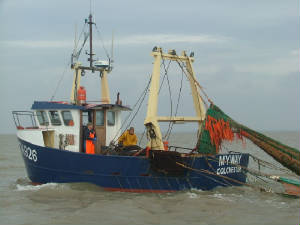|
|
 |
|

About the fleet
The
fleet within the district is mainly composed of small under 10m boats which tend to fish on ‘day trips’ and travel
up to a maximum of 25 nm from port working within the 6 or 12 mile limits. In
total there are about 275 licensed fishing vessels in the district which provide full time employment for over 300 people. The main fishing ports within the district include Dungeness, Folkestone, Ramsgate,
and Whitstable in Kent and Leigh-on-Sea, West Mersea and Harwich in Essex. Fishing
boats also land at a range of other smaller ports within the district, with some vessels in Kent (Herne Bay, Deal, Hythe and
Dungeness) landing on the beach.
|
 |
What type of fish are caught?
A variety of static and mobile gears are used
within the district including
trawling, pair trawling, drift/fixed netting, potting, scallop and oyster dredging and cockle dredging. Different gear is deployed according to the target species and the type of gear used varies with the seasonal fluctuation
of each fishery.
Within
the district, trawlers and netters land a variety of fish including soles, plaice, dab, bass, cod, herring, sprat and thornback
rays. Other vessels within the district also land scallops, oysters, whelks,
lobster and, to a lesser extent, mussels and crab. Cockle harvesting is one of
the most productive fisheries within the district and has a range of management measures designed to maintain the stock at
sustainable levels (see byelaws – Cockles). Within the Thames some boats
also dredge for whiteweed (a form of hydroid) which, after being processed, can be dyed and sold as decorations.
|
 |
|
|
|
Recreational fisheries
The
area covered by the Kent and Essex Sea Fisheries Committee encompasses a wide variety of recreational sea angling opportunities
including piers and harbours, creeks and deep-water, estuaries and open sea, sandy shallow beaches and deeply shelving gravel
beaches. Within these areas there are a huge variety of fin fish species of interest to recreational sea anglers. Most common species include bass, thornback ray, smooth hound, grey mullet, cod and whiting.
Being
close to the dense populations of London and the South East, the district’s recreational sea fisheries also attract
visitors from further afield supporting businesses and livelihoods comprised of the many angling charter boats, bait-diggers,
tackle shops, and angling guides etc.
There
are a large number of sea angling clubs in the district, many of them organising shore-based competitions, and with large
areas of sheltered water and plentiful marinas and slipways, the area also attracts many privately owned angling boats.
The
recreational sea fisheries within the district are a valuable asset to the economy of the region, encouraging spending on
tourism and leisure as well as providing a useful recreational activity for many people, bringing them into intimate contact
with the marine environment.
|
|
|
 |

